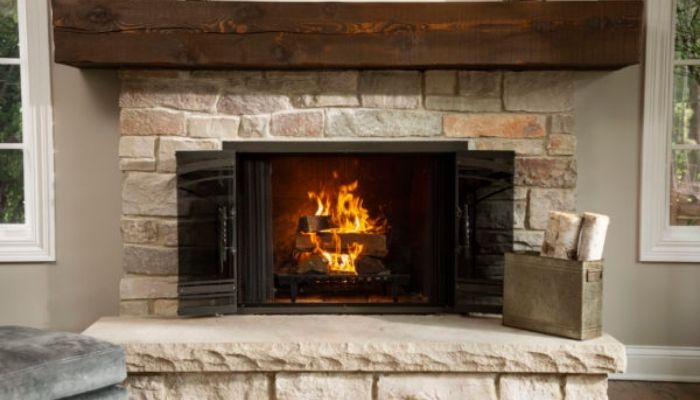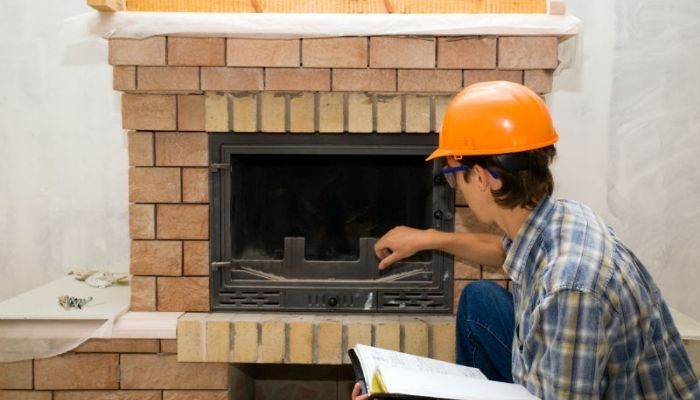Gas fireplaces are often installed on existing masonry block fireplaces meant for wood-burning. So, the house you inherit or buy may affect whether your gas fireplace will have a chimney. Gas fireplaces can utilize the existing chimneys to their advantage. However, Do gas fireplaces need a chimney to be installed and operated?
A flue system is important for a natural vent gas fireplace unit. You can install the system within a chimney to facilitate the installation and operation of a natural vent gas fireplace. Ventless and direct gas fireplaces do not need a chimney to operate. Therefore, the type of gas fireplace will determine whether the fireplace needs a chimney or not.
Natural Vent Gas Fireplaces
A chimney is key for the operation of a natural vent gas fireplace. They are sometimes referred to as B-vent gas fireplaces. The chimney helps to exhaust the waste air from the gas fireplace. Moreover, they are traditionally installed on existing masonry fireplaces. The advantage is that you are converting a less efficient wood-burning fireplace to a more efficient gas fireplace.
Natural gas fireplaces take air in from the homes to feed the flames of the gas fireplace. In the process of combustion, waste air is generated in the fireplace. This is where the existing chimney above the masonry fireplace becomes important. The waste gas is released through the chimney to allow fresh air to enter.
You cannot thus move a natural vent gas fireplace to any other location in the home. The other types of gas fireplaces would be suitable for use in the other rooms. Another option is to construct a chimney in the other rooms to install the chimney. This may, however, prove to be expensive.
Direct Vent Gas Fireplaces
A chimney is not important for a direct vent gas fireplace. They can be directly vented through the roof or an external wall. They do not need to sit under a chimney-like the natural vent gas fireplace.
The air used for combustion is drawn from the exterior of the house. The same with waste air which is vented to the outside of the building. This makes it more flexible than a traditional natural vent gas fireplace. You can thus install it in many different locations.
The dual vent pipe at the back of the unit is a common venting arrangement. The pipes can run horizontally across the external wall. However, the waste pipe can be placed higher or run vertically through the roof. This makes direct vent gas fireplaces sealed systems. It is thus impossible for the air to and from the gas fireplace to mix with gas within your home.
If you bought a house with no masonry fireplace, this is the best option. You can also place them in other rooms lacking a chimney.
Ventless Gas Fireplaces
Ventless gas fireplaces do not require chimneys at all. The fresh and waste air does not need to be vented in and out of the house. The technology is that the gas fireplace burns cleanly enough such that there are no direct vents required. The exhaust air is released back into the air within the home.
The production of minimal waste air makes them suitable for many homes. However, you may be forced to provide ventilation depending on where you live. This is according to the building codes of an area. They can thus use them in many rooms due to their flexibility.
Issues With Ventless Gas Fireplaces
- Oxygen depletion; The process is low and thus hard to notice. However, ventless gas fireplaces can use up the oxygen in the room. You should thus use it for short bursts and supplement it with a central heating unit.
- Carbon monoxide buildup; Just like the other types of gas fireplaces, it releases exhaust fumes into the room. Accumulation of carbon monoxide can be fatal. Do not use it for too long.
- Fire hazard; allowing a ventless gas fireplace to overheat can cause a fire. Has it been maintained once a year to prevent this?
- Mold from moisture; Ventless gas fireplaces also produce water vapor. Without proper cleaning, molds can grow.
Conclusion
A gas fireplace is an ideal unit to have in your home. Chimneys are important depending on the gas fireplace intended to be installed. Natural vent gas fireplaces require chimneys more than any gas fireplace. Direct gas and ventless gas fireplace do not require a chimney at all. The most important thing is to ensure there is no build-up of waste gases.


